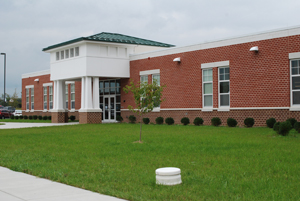First LEED Gold Public School in West Virginia
 MARTINSBURG, W. Va. — Spring Mills Primary School is the first public school in West Virginia to achieve LEED Gold certification.
MARTINSBURG, W. Va. — Spring Mills Primary School is the first public school in West Virginia to achieve LEED Gold certification.
“Berkeley County is fortunately one of the few counties in the state of West Virginia that is a growing county. They’ve had an active building program for the last ten or twelve years, so this was a need for a new school facility to accommodate their growth,” said Bill Ratcliffe, education facilities planner and construction contract administrator for Williamson Shriver Architects Inc.
The district is a neighbor to Montgomery County, Md., where Seneca Creek Elementary was the first LEED-certified school for that state. With the two districts less than an hour apart, members of Berkeley County School District where able to go and look at the building and concept.
Construction started in 2009 with a 14-month length of construction ending in April 2011, thus allowing occupancy in August 2011. Design for the school began in 2006 with Williams Shriver, with the three-year period used to obtain funding and prepare the project, according to Ratcliffe.
Funding for the school came from the School Building Authority of West Virginia and Berkeley County Schools in spring 2009. Money from the county comes through either capital improvements or a local bond; the other funds mostly come from state lottery funds.
The total project cost was approximately $12.6 million. Maximum capacity for the school is 575 students with a building area of 63,380 square feet.
“The [former] superintendent wanted to make this an educational experience on how we do things, why we do things and what it does for our environment,” said Manny Arvon, superintendent of Berkeley County. “We wanted this school to encourage conversation, and conversation leads to education, which leads to environment issues.”
Math and science teachers put together a curriculum dealing with the environmental issues regarding the green school in order to inform students about the buildings they were in and the impacts on the surroundings.
According to Arvon, one of the best parts of teaching is that it continues outside of the classroom, and having a LEED Gold institution promotes that even more.
“The best part of education is when children go home and are sitting down with their parents or grandparents or aunts and uncles and are talking about what went on that day in school,” said Arvon. “When they talk about for instance how we deal with the excess food in the cafeteria and how it’s ground and used for mulching — things that kids go home and talk about — that starts becoming part of the conversation in the household, with those practices our students are learning about carrying over in to the community.”
The K-2 school achieved LEED Gold due to a number of design elements implemented by Charleston, W.Va-based Williamson Shriver Architects Inc. Features contributed to reductions in energy, lighting, water and material use, as well as other sustainable strategies.
The intended certification target for Spring Mills was LEED Silver, but by the end of the project, LEED Gold was attainable.
“Silver certified was the one we started evaluating and it started getting to ‘well if we do this, and this is only a little bit more, look how close we are’ and we started evaluating what was in this building and what other items were reachable and so we just started aiming higher,” said Arvon.
Spring Mills is estimated to use 33 percent less energy due to an insulated concrete form wall system, natural daylighting, a geothermal HVAC system and enhanced roof insulation.
Daylighting was achieved by classroom orientation to either north or south with oversized windows, light wall colors, high-sloped ceilings and electronic daylighting sensors.
The school will also use a kitchen waste pulping system and decomposing unit that will reduce the amount of food waste taken into landfills. The reduction will come to about 78 percent of what other schools in the district take, since remaining waste will be used as mulch or fertilizer.
Waterless urinals, dual-flush toilets and reduced-flow kitchen equipment will utilize over 30 percent less water than a conventional school building of the same size.
In addition to obtaining LEED certification, the project received a Merit Award for Achievement in Architecture in Sustainable Design for 2012 from the West Virginia chapter of the AIA.
